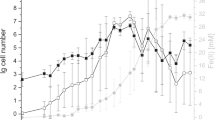Abstract
Monoxenic cultures of the anaerobic, endosymbiont-free ciliate Trimyema compressum were incubated with low numbers of Bacteroides sp. strain WoCb15 as food bacteria and two strains (DSM 3636 and 3637) of Methanobacterium formicicum, which originally had been isolated from the anaerobic protozoa Metopus striatus and Pelomyxapalustris. The ciliate which had lost its original endosymbiotic methanogens ingested both strains of M. formicicum. The methanogenic bacteria were found intact in large vacuoles in contrast to the food bacteria which were digested. Single methanogens were separated from the vacuoles and appeared surrounded by a membrane in the cytoplasm of the ciliate. After 2 months of incubation, the methanogenic bacteria still exhibited the typical bluish fluorescence and the new symbiotic association of M. formicicum and T. compressum excreted methane. Increasing the growth rate of the ciliates by large numbers of food bacteria resulted in a loss of the methanogenic bacteria, due to statistical outgrowth.
Similar content being viewed by others
References
Archer DB, Harris JE (1984) Methanogenic bacteria and methane production in various habitats. In: Barnes EM, Mead GC (eds) Anaerobic bacteria in habitats other than man. Symposium of the Society for Applied Bacteriology. Blackwell, Oxford
Boone D, Bryant MP (1980) Propionate-degrading bacterium Syntrophobacter wolinii sp. nov. gen. nov., from methanogenic ecosystems. Appl Environ Microbiol 40:626–632
Cappenberg TE (1974) Interrelations between sulfate-reducing and methane-producing bacteria in bottom deposits of a fresh-water lake. I. Field observations. Antonie van Leeuwenhoek 40:285–295
Doddema HJ, Vogels GD (1978) Improved identification of methanogenic bacteria by fluorescence microscopy. Appl Environ Microbiol 36:752–754
Fujishima M, Görtz HD (1983) Infection of macronuclear Anlagen of Paramecium caudatum with the macronucleus-specific symbiont Holospora obtusa. J Cell Sci 64:137–146
Goosen NK, Horemans AMC, Hillebrand SJW, Stumm CK, Vogels GD (1988) Cultivation of the sapropelic ciliate Plagiopyla nasuta Stein and isolation of the endosymbiont Methanobacterium formicicum. Arch Microbiol 150:165–170
Görtz HD (1983) Endonuclear symbionts in ciliates. In: Jeon KW (ed) Intracellular symbiosis. Int Rev Cytol [Suppl] 14:145–176
Kandler O, König H (1978) Chemical composition of the peptidoglycan-free cell walls of methanogenic bacteria. Arch Microbiol 118:141–152
König H, Kralitz R, Kandler O (1982) Structure and modifications of pseudomurein in Methanobacteriales. In: Kandler O (ed) Archaebacteria. Fischer, Stuttgart, pp 179–191
Lindmark DG, Müller M (1973) Hydrogenosome, a cytoplasmic organelle of the anaerobic flagellate, Tritrichomonas foetus, and its role in pyruvate metabolism. J Biol Chem 248:7724–7728
McInerney M, Bryant MP, Hespell RB, Costerton JM (1981) Syntrophomonas wolfei gen. nov. sp. nov., an anaerobic, syntrophic, fatty-acid oxidizing bacterium. Appl Environ Microbiol 41:1029–1039
Müller M (1988) Energy metabolism of protozoa without mitochondria. Annu Rev Microbiol 42:465–488
Pfennig N (1978) Rhodocyclus purpureus gen. nov. and spec. nov., a ring-shaped vitamin B12-requiring member of the family Rhodospirillaceae. Int J Syst Bacteriol 28:283–288
Reisser W, Meier R, Görtz HD, Jeon KW (1985) Establishment, maintenance, and integration mechanism of endosymbionts in protozoa. J Protozool 32:383–390
Stumm CK, Gijzen HJ, Vogels GD (1982) Association of methanogenic bacteria with ovine rumen ciliates. Br J Nutr 47:95–99
Van Bruggen JJA, Stumm CK, Vogels GD (1983) Symbiosis of methanogenic bacteria and sapropelic protozoa. Arch Microbiol 136:89–95
Van Bruggen JJA, Zwart KB, Van Assema RM, Stumm CK, Vogels GD (1984) Methanobacterium formicicum, an endosymbiont of the anaerobic ciliate Metopus striatus McMurrich. Arch Microbiol 139:1–7
Van Bruggen JJA, Van Rens GLM, Geertman EJM, Zwart KB, Stumm CK, Vogels GD (1988) Isolation of a methanogenic endosymbiont of the sapropelic amoeba Pelomyxa palustris Greeff. J Protozool 35:20–23
Vogels GD, Hoppe WF, Stumm CK (1980) Association of methanogenic bacteria with rumen ciliates. Appl Environ Microbiol 40:608–612
Wagener S, Stumm CK, Vogels GD (1986) Electromigration, a tool for studies on anaerobic ciliates. FEMS Microbiol Ecol 38:197–203
Wagener S, Pfennig N (1987) Monoxenic culture of the anaerobic ciliate Trimyema compressum Lackey. Arch Microbiol 149:4–11
Widdel F, Pfennig N (1981) Studies on dissimilatory sulfate-reducing bacteria that decompose fatty acids. I. Isolation of new sulfate-reducing bacteria enriched with acetate from saline environments. Description of Desulfobacter postgatei gen. nov. sp. nov. Arch Microbiol 129:395–400
Widdel F, Kohring GW, Mayer F (1983) Studies on dissimilatory sulfate-reducing bacteria that decompose fatty acids. III. Characterization of the filamentous gliding Desulfonema limicola gen. nov. sp. nov., and Desulfonema magnum sp. nov. Arch Microbiol 134:286–294
Widdel F, Pfennig N (1984) Dissimilatory sulfate-or sulfur-reducing bacteria. In: Krieg NR, Holt JG (eds) Bergey's manual of systematic bacteriology. IXth edn, vol I. Williams & Wilkins, Baltimore London, pp 663–679
Williams AG (1986) Rumen holotrich ciliate protozoa. Microbiol Rev 50:25–49
Wolin MJ, Miller TL (1982) Interspecies hydrogen transfer: 15 years later. ASM News 48:561–565
Zaiss U (1981) Seasonal studies of methanogenesis and desulfurication in sediments of the river Saar. Zbl Bakt Hyg, I Abt Orig C 2:76–89
Zeikus JG, Winfrey MR (1976) Temperature limitation of methanogenesis in aquatic sediments. Appl Environ Microbiol 31:99–107
Zwart KB, Goosen NK, Van Schwijndel MW, Broers CAM, Stumm CK, Vogels GD (1988) Cytochemical localization of hydrogenase activity in the anaerobic protozoa Trichomonas vaginalis. Plagiopyla nasuta and Trimyema compressum. J Gen Microbiol 134:2165–2170
Author information
Authors and Affiliations
Rights and permissions
About this article
Cite this article
Wagener, S., Bardele, C.F. & Pfennig, N. Functional integration of Methanobacterium formicicum into the anaerobic ciliate Trimyema compressum . Arch. Microbiol. 153, 496–501 (1990). https://doi.org/10.1007/BF00248433
Received:
Accepted:
Issue Date:
DOI: https://doi.org/10.1007/BF00248433




